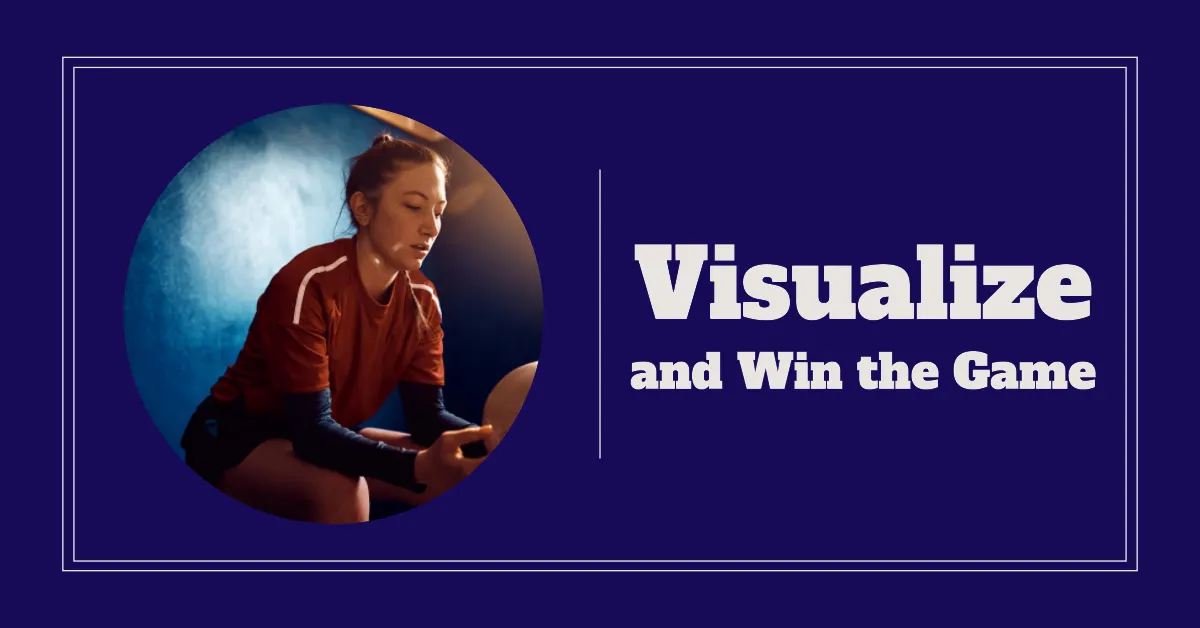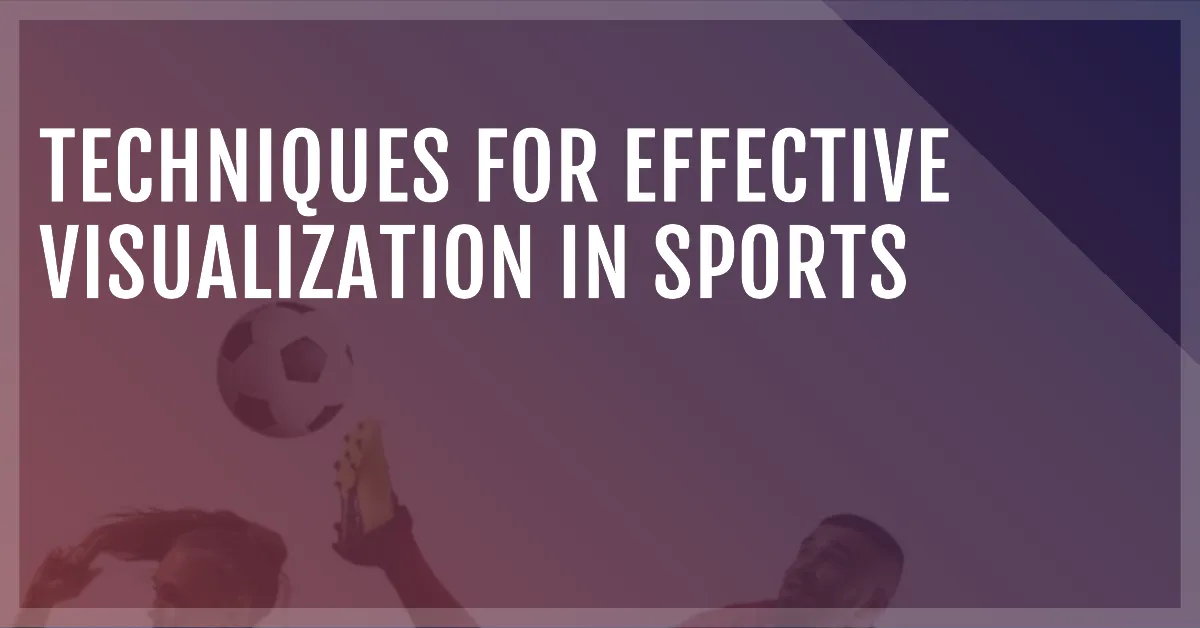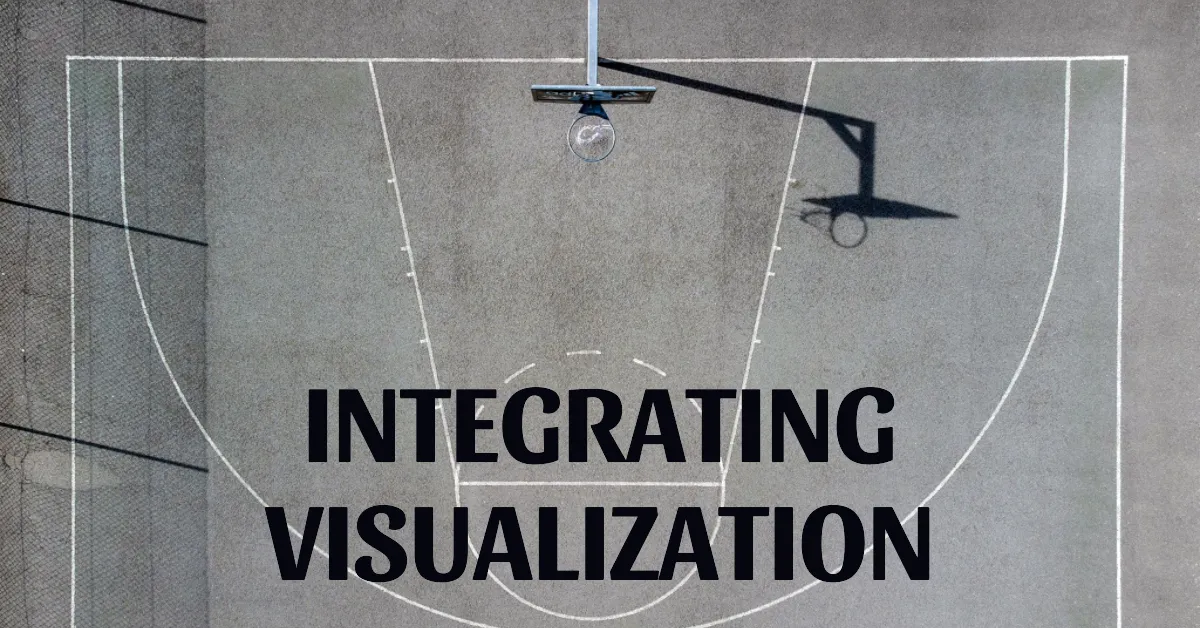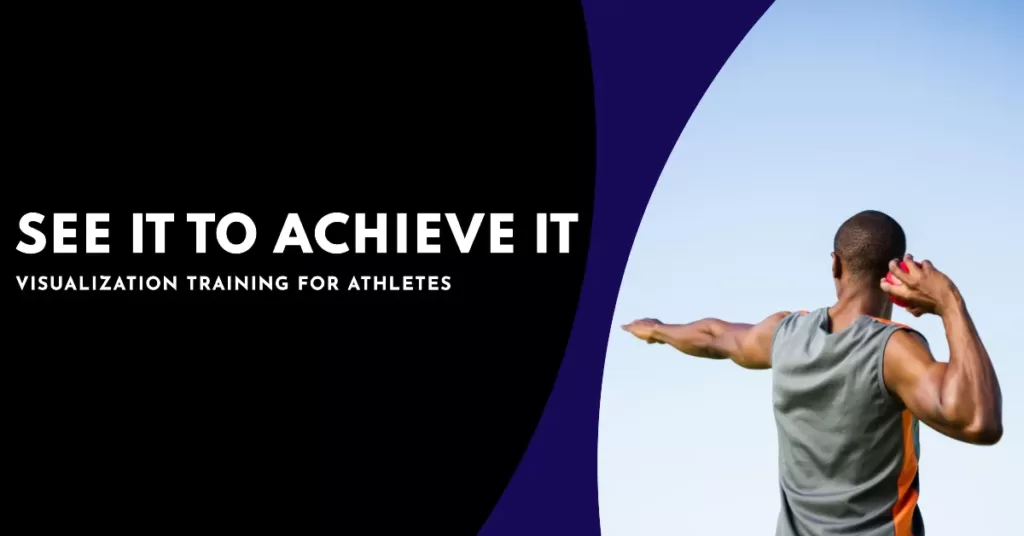In the world of sports, physical strength and skill are undoubtedly crucial for athletes to excel. However, there is a hidden power that lies within the minds of these exceptional individuals – the ability to visualize success. Sports visualization, often overlooked yet immensely powerful, has become an integral part of training for athletes across various disciplines. This article aims to delve into the depths of this mental conditioning technique, offering insights on how to effectively harness its potential and exploring the emotional aspects that come along with it. So grab a seat and get ready to embark on a journey through the realm of visualization training as we uncover its secrets from the perspective of a seasoned mental conditioning coach.
Table of Contents
Why Visualization Training Is Important for Athletes?
Being a mental conditioning coach myself, I cannot emphasize enough the importance of visualization training for athletes. The power of mentally rehearsing their performance can be a game-changer not only in enhancing their physical skills but also in developing the right mindset. When athletes create vivid mental images of themselves successfully executing a technique or achieving their desired outcome, they are activating neural pathways in the brain that mimic real-life experiences. This process creates familiarity and builds confidence, allowing them to perform under pressure with greater ease.
But visualization training goes beyond just imagining the end result; it involves engaging all senses in recreating the entire experience. Studies have shown that when athletes incorporate sensory details like sounds, smells, and even physical sensations into their visualizations, they activate different regions of the brain associated with those senses. This multisensory approach strengthens the mind-body connection and helps athletes respond more instinctively during competition.
Moreover, visualization training has a profound impact on an athlete’s psychology. By repeatedly visualizing themselves overcoming challenges and bouncing back from setbacks, athletes develop resilience and perseverance in the face of adversity. They learn to manage stress and anxiety by rewiring their brains to focus on positive outcomes rather than dwelling on potential failures. When practiced consistently over time, this mental conditioning technique equips athletes with valuable psychological tools that enhance not just their performance but also their overall wellbeing.
In short, incorporating visualization training as part of an athlete’s routine is essential for optimal performance both physically and mentally.
Benefits of Visualization Training

Visualization training is a powerful tool that can enhance an athlete’s performance both on and off the field. While physical training is crucial, the mental aspect of sports should not be overlooked. By incorporating visualization techniques into their practice routine, athletes can improve their focus, increase confidence, and even enhance their muscle memory.
One of the key benefits of visualization training is its ability to improve an athlete’s focus. When an athlete visualizes themselves executing a specific technique or skill in their mind’s eye, they are essentially rehearsing that action without actually performing it physically. This allows them to concentrate on every detail and perfect their execution mentally before attempting it in real life. The heightened focus gained through visualization can translate to improved concentration during actual competition.
Another advantage of visualization training is its impact on an athlete’s confidence levels. By vividly imagining successful performances over and over again, athletes instill a sense of belief in themselves which directly affects their self-confidence. They become more certain about what they are capable of achieving and are less likely to doubt themselves when facing high-pressure situations. This increased confidence can have a profound effect on an athlete’s overall performance as they approach each game or competition with greater self-assurance.
Coaches who incorporate visualization training into their coaching methodologies also benefit by having athletes who are better equipped mentally for challenges that arise during competitions and games. Visualization enhances an athlete’s ability to problem-solve quickly by envisioning various scenarios and preparing for different outcomes mentally before encountering them physically.
Improved Performance and Mental Focus
Practice visualization is a technique that has been used by athletes for decades to improve their performance and mental focus. By mentally rehearsing their actions, athletes are able to create a clear picture of what they want to achieve, helping them to better execute their skills when it matters most. This method has become so popular that many sports psychologists now incorporate visualization training into their programs.
One reason why visualization training is so effective is that it allows athletes to bypass the physical limitations of practice. When an athlete visualizes themselves performing a specific skill or technique, the same neural pathways are activated in the brain as if they were physically doing it. This means that with enough mental practice, an athlete can actually strengthen the connections between their brain and muscles, leading to improved performance on the field.
Another benefit of practicing visualization is its impact on an athlete’s mental focus. In high-pressure situations, such as a crucial game or race, it’s common for athletes to struggle with distractions and negative thoughts. However, by regularly engaging in visualization exercises, athletes learn how to quiet their minds and stay focused on their goals. As a result, they are able to maintain concentration under pressure and perform at their best when it matters most.
To put it simply, visualization training has proven time and again to be an effective tool for enhancing performance and mental focus in sports. By incorporating this practice into their training regimen, athletes can tap into the power of their minds and unlock new levels of success on the field or track.
Increased Confidence and Motivation
As a mental conditioning coach, I have witnessed firsthand the transformative power of visualization training on athletes’ confidence and motivation. The mental game is just as important, if not more, than the physical aspect of sports performance. By incorporating visualization techniques into their training regimen, athletes are able to create a vivid mental image of themselves succeeding in their sport. This not only boosts their confidence but also enhances their motivation to put in the necessary work to make that vision become a reality.
One intriguing aspect of visualization training is its ability to activate the subconscious mind. When athletes visualize themselves achieving their goals, they send powerful messages to their subconscious that reinforce positive beliefs and attitudes. This programming at a deeper level can significantly impact an athlete’s confidence and motivation by eliminating self-doubt and instilling a strong belief in their abilities.
Additionally, visualization training helps athletes develop a heightened sense of focus and drive. By visualizing specific scenarios such as executing flawless techniques or making critical plays under pressure, athletes train their minds to stay locked in on the task at hand. This laser-like focus translates into increased motivation as they are more determined than ever to reach their desired outcome. Visualization empowers them with a clear mental roadmap toward success and propels them forward even when faced with challenges or setbacks.
In essence, visualization training holds immense potential for enhancing an athlete’s confidence and motivation by engaging both the conscious and subconscious mind.
Enhanced Muscle Memory and Skill Acquisition
Enhanced muscle memory and skill acquisition are key components of an athlete’s success. While physical training is essential, mental conditioning plays a significant role in unlocking an athlete’s full potential. One powerful tool that can elevate an athlete’s performance to the next level is visualization training.
By visualizing themselves executing specific movements or techniques repeatedly in their minds, athletes activate the same neural pathways that would be engaged during actual physical practice. This process strengthens the connection between their brain and muscles, enhancing muscle memory. Consequently, when it comes time to execute those movements on the field or court, athletes are better equipped to perform at a higher level with more precision and efficiency.
Moreover, visualization training not only enhances muscle memory but also provides athletes with a mental edge. Through consistent visualization practice, athletes become highly skilled at adapting to different game scenarios and handling pressure situations effectively. By mentally rehearsing complex plays or challenging moments ahead of time, they develop confidence in their abilities and learn to trust their instincts when faced with real-life challenges on the playing field.
Enhanced muscle memory and skill acquisition through visualization training can give athletes that much-needed edge over their competitors. By incorporating this mental conditioning technique into their training regimen, athletes can accelerate their progress and unlock hidden potential within themselves. So whether you’re an aspiring young talent or a seasoned pro looking for ways to improve your game further, consider integrating visualization training into your routine – it might just be the missing piece needed for optimal athletic performance.
Techniques for Effective Visualization

As a mental coach, I often find that athletes overlook the importance of visualization training in their overall performance. While many may assume it to be a simple exercise of imagining success, effective visualization techniques go beyond just creating mental images. One such technique is incorporating all senses into the visualization process. By not only visualizing but also engaging other senses – such as touch, smell, or sound – an athlete can create a more immersive experience that reflects the reality of their sport.
Another technique for effective sports visualization is focusing on motor skills. Instead of solely picturing the end result, athletes should visualize themselves going through each step of their specific action or movement. Whether it’s swinging a bat or executing a flawless dive, mentally rehearsing these motor skills helps to refine muscle memory and enhance coordination during actual performance. By honing in on the details and intricacies of each movement through visualization, athletes can sharpen their execution and boost overall performance on game day.
Incorporating all senses and focusing on precise motor skills are just two key techniques that can take your sports visualization to new heights. By diving deeper into what it means to visualize effectively and strategically practicing these techniques, athletes can unlock immense potential in their mental preparation for competition. With consistency and dedication to this aspect of training, athletes will see improvements not only in their confidence levels but also in their ability to execute at peak performance when it matters most.
Creating Detailed Mental Imagery
Countless times I have witnessed the transformative power of visualization for athletes firsthand. Creating detailed mental imagery is a crucial tool that can take your performance to new heights. When you engage all your senses and vividly imagine each aspect of your sport, you are essentially tricking your brain into believing that you are actually in action.
One effective technique for creating detailed mental imagery is to start by focusing on specific movements or skills in slow motion. Imagine every minute detail: the position of your body, the feel of the equipment in your hands, even the sounds around you. By slowing down the images in your mind, you can pinpoint any flaws or weaknesses that need attention and make adjustments accordingly.
Another valuable strategy is to incorporate emotions and positive outcomes into your visualization practice. Imagine yourself executing every move flawlessly and experiencing feelings of confidence, success, and joy. Research has shown that when athletes visualize themselves performing at their best with positive emotions attached, it has a direct impact on their performance on game day.
Mastering the art of creating detailed mental imagery through visualization is an essential aspect of mental training for athletes. By engaging all our senses and incorporating emotions into our practice, we can enhance our focus and improve our overall performance. So go ahead, close those eyes, and paint a vivid picture in your mind – it might just be the secret ingredient that propels you toward greatness on the field or court.
Engaging All Senses During Visualization
Engaging all the senses during visualization can significantly enhance an athlete’s performance on the field. While most athletes focus solely on visualizing their movements and strategies, incorporating other sensory experiences can provide a more vivid and immersive mental rehearsal. By engaging all senses (five “main”: sight, hearing, touch, taste, and smell + the additional ones: proprioception, enteroception, etc.) athletes create a comprehensive mental blueprint that prepares them for any situation. It is called visceralization and it is an advanced form of visualization.
For example, if you are a basketball player visualizing yourself making a crucial three-point shot, don’t just imagine the sight of the ball going through the net. Bring in the auditory experience too; hear the resounding swish as it passes through. Feel the texture of the ball in your hands – its slight indentations and grip against your fingertips – before releasing it with precision. Pay attention to how your body moves, what it communicates to you during the shot, and what it feels like to produce this specific amount of force. Imagine tasting victory as you nail that shot while also smelling anticipation in the air from your teammates and fans.
When an athlete engages all senses during visualization training, they activate multiple areas of their brain associated with each respective sense. This not only strengthens neural connections but also enhances muscle memory and proprioception to simulate real-life scenarios more accurately. By immersing oneself completely in this multisensory experience, one is better prepared to perform at their best as they have already mentally rehearsed every aspect of it.
So why limit your visualization practice to just visual cues? Engage all senses to create a holistic mental representation that primes both mind and body for success on game day.
Practicing Regularly and Consistently
Consistency is key when it comes to visualization training for athletes. Many athletes underestimate the power of regular and consistent practice, often thinking that occasional visualization sessions are enough. However, just like physical training, mental conditioning for sports performance requires continuous effort and dedication.
Practicing regularly allows you to develop a strong connection between your mind and body. By visualizing your actions repeatedly, you not only reinforce the neural pathways in your brain but also familiarize your muscles with the movements you want to execute on the field or court. This consistency builds confidence and creates a sense of familiarity with the desired performance, making it easier to bring those visualized actions into reality during actual competition.
Moreover, by practicing consistently, you train yourself to stay focused for longer periods. Just as physical endurance improves with consistent exercise, mental stamina also increases over time. Regular visualization sessions help lengthen your attention span and enhance concentration skills – crucial attributes for peak athletic performance. So don’t underestimate the importance of setting aside time every day for visualization training – make it a habit that becomes an integral part of your overall preparation routine as an athlete.
Integrating Visualization into Training Routine

Integrating visualization into your training routine can have a profound impact on your performance as an athlete. While physical training is essential for building strength and endurance, mental conditioning plays an equally important role in achieving peak performance. Visualization allows you to mentally rehearse your actions before executing them physically, optimizing your focus and increasing your chances of success.
By visualizing yourself in various scenarios on the field or court, you can enhance your decision-making ability and reaction time. In fact, studies have shown that athletes who regularly use visualization techniques experience improved performance compared to those who solely rely on physical practice. This is because visualization allows you to train your brain to respond effectively under pressure, leading to enhanced confidence and composure during actual competition.
Moreover, integrating visualization into your training routine can help with injury prevention and rehabilitation. Visualizing the proper form while performing exercises or movements helps develop muscle memory without putting excessive strain on the body. Additionally, by envisioning yourself recovering from an injury successfully, you can accelerate the healing process by focusing on positive outcomes. Incorporating visualization techniques alongside physical training not only strengthens both body and mind but also brings about a holistic approach to athletic development.
Implementing visualization into your training routine has numerous benefits for athletes seeking optimal performance. By utilizing this powerful mental conditioning tool, you can improve decision-making skills, increase confidence under pressure situations, prevent injuries through proper form reinforcement, and aid in injury recovery.
Pre-game or Pre-performance Visualization
As a coach, I have witnessed firsthand the incredible power of pre-game or pre-performance visualization. This technique involves mentally rehearsing and envisioning oneself successfully executing every aspect of the upcoming athletic event or performance. By vividly imagining each movement, strategy, and outcome, athletes can cultivate a state of focused readiness that often translates into improved performance on the field.
In addition to building an athlete’s confidence and reducing anxiety, pre-game visualization also serves as a valuable tool for goal setting. By visualizing themselves achieving specific goals – whether it’s scoring a winning touchdown or nailing that high note in a musical recital – athletes can enhance their motivation and drive to succeed. Visualizing success in this way helps athletes align their actions and mindset with their desired outcome, making it more likely for them to perform at their best when faced with game-time pressure.
Moreover, pre-game visualization offers an opportunity for athletes to practice dealing with unexpected challenges. By imagining different scenarios – such as facing a tough opponent or recovering from setbacks during the game – athletes train their minds to react calmly and effectively in real-life situations. This mental rehearsal prepares them for navigating uncertain circumstances while maintaining focus on their end goal.
Adding pre-game or pre-performance visualization into the training arsenal can greatly benefit athletes by enhancing confidence levels, clarifying goals, and improving adaptability under pressure.
Visualization During Rest and Recovery Periods
During rest and recovery periods, athletes often focus on physical relaxation and rejuvenation. However, integrating visualization techniques into these crucial moments can greatly enhance their overall mental conditioning. Visualization is like a mental workout that allows athletes to envision themselves successfully executing their desired skills or performances. Similar to physical training, the more an athlete practices visualizing their ideal outcomes during rest and recovery, the more deeply ingrained those positive images become in their minds.
By incorporating visualization into their downtime, athletes can strive for consistency in both mental and physical realms. While resting the body allows muscles to repair and rebuild, engaging in visualization exercises enables the mind to strengthen neural pathways associated with successful performance. Additionally, this practice promotes emotional wellbeing by reducing anxiety levels during competitions or high-pressure situations. Athletes may find that after visualizing a successful outcome during rest periods, they experience an increased sense of confidence when it comes time to step back onto the field or court.
Incorporating visualization into rest periods not only fuels athletic success but also fosters innovation and creativity within training routines. During these moments of relaxation, athletes have an opportunity to visualize novel tactics or strategies that could potentially give them an edge over competitors. The power of imagination should not be underestimated – by mentally rehearsing new approaches while recovering from intense workouts or competitions, athletes can explore uncharted territories without adding stress or fatigue to their bodies. Thus, dedicated visualization during rest becomes a crucial tool for evolving as an athlete and continuously developing one’s skills.
Summary: Why Athletes Should Engage in Imagery Training?
Incorporating visualization training into an athlete’s routine is of utmost importance when seeking to optimize performance. It has often been said that success begins in the mind, and this holds true for athletes as well. By harnessing the power of their imagination, athletes can mentally rehearse and prepare themselves for various scenarios and challenges they may encounter on the field or in court.
Sports visualization not only helps athletes improve focus and mental clarity but also enhances their physical capabilities by creating a strong mind-body connection.
Think of sports visualization as a secret weapon championed by top-performing athletes. The ability to visualize success builds confidence, reduces anxiety, and helps navigate high-pressure situations with grace and composure. It serves as a valuable tool in an athlete’s mental arsenal, alongside physical conditioning. Just like any other aspect of training, regular practice is key to mastering visualization techniques and reaping their benefits. So why not take some time each day to close your eyes, envision your goals being achieved, and feel the rush of victory running through your veins? The results may just surprise you – unlocking new levels of performance previously untapped while propelling you toward greatness on the field or court.




